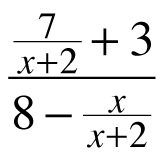I have been trying to use CPM’s new Precalculus textbook as a guide for my pre-calculus class. During my planing period, I opened to the next lesson to try to put together a plan for my upcoming class.
I only had about one hour to prepare for this class period.
This was the opening prompt:
Gerrit wants to simplify the complex fraction
but is overwhelmed by the fractions within a fraction. Work with your team to help Gerrit write an equivalent expression that is a rational expression instead of a complex fraction. Be ready to share your strategies with the class.
I approached this task thinking about the 5 Practices for Orchestrating Productive Math Discussions. I worked through simplifying the complex fraction in different ways, trying to anticipate different student approaches.
I stopped to think about how this would work with my class:
- I thought back to when I addressed this topic last year – and how poorly it went. Students were frantically writing steps to memorize procedures. Although I am experienced enough to avoid saying “copy-dot-flip” or “invert & multiply“, I know this is how my students learned to divide fractions and it is how they approached these problems.
- I decided I did not want to teach this the same way this time.
- I considered just doing the lesson as described by CPM because I really didn’t have much time to plan and it was good enough. They are HS seniors. I can’t change their perspective on math and learning at this point – right? I tell myself this sometimes. To just keep it simple, but I never listen.
- I read Dan Meyer’s blog post “If Simplifying Rational Expressions Is Aspirin Then How Do You Create The Headache?” I pictured myself asking students to evaluate a complex expression for specific values and whether or not they would be surprised (or even care) if I could evaluate the expression quickly. They have been beaten down by math for most of their lives. I thought this would just be another instance where a math teacher made them feel less competent, and that did not seem like a productive way to pique their interest.
- I thought about when I recently re-read Lockhart’s Lament, especially this part:
“I don’t see how it’s doing society any good to have its members walking around with vague memories of algebraic formulas and geometric diagrams, and clear memories of hating them … Mathematics should be taught as art for art’s sake. These mundane “useful” aspects would follow naturally as a trivial by-product.”
- I thought about Tracy Zagar’s session that I recently attended at ATMNE’s Conference where she talked about how connections through multiple representations made explicit can help students to develop understanding. Tracy also asked participants to think about related topics, often taught separately resulting in learners thinking of math topics as separate concepts. We identified related math topics that are taught separately such as:
- graphing lines: f(x)=mx+b and transformations of functions f(x)=a f(x-h)+k
- similarity and slope
- adding and subtracting
- fractions and division
- I thought about Richard Skemp’s article, Relational Understanding and Instrumental Understanding, and how I could help my students see the simplicity and beauty in simplifying complex fractions.
“There are two kinds of simplicity: that of naivety; and that which, by penetrating beyond superficial differences, brings simplicity by unifying.”
At this point I was losing valuable planning time, but I decided it was more important for me to make sense of dividing fractions for myself, and help students to experience the joy in understanding, than it was to have a flawless detailed lesson plan, so I found and worked through Graham Fletcher’s Making Sense of Invert and Multiply. During my lunch, I created and thought through as many cases of dividing fractions as I could come up with. Then I selected a few to use with my students.
I decided against starting with the opening question provided in CPM’s textbook above, I thought I would close with that question.
I decided to open the lesson asking students to think about and share how they would represent the number of groups of 1/2 that are in 3/4. Instead of beginning my class with these learners feeling intimidated and overwhelmed, they were curious.
Students discussed and compared representations, made connections and got genuinely excited at the silliness of being in a college credit pre-calculus class and that we were making sense of fourth and fifth grade mathematics. Mid-discussion, one high school senior yelled “I am in 12th grade and I just now understand how dividing fractions works!” Shaking her head with a mix of frustration towards how math is taught and satisfaction that she understood division of fractions.
Once they were ready, students worked in pairs on whiteboards to think through CPM’s opening question. They took time, consulted and corrected each other and all ended with the same simplification in different ways. Then the craziest thing happened:
They asked me for more complex fractions to simplify!


































 Students developed a genuine understanding of the process, which will hopefully lead them to increased success as they begin algebra 2 next school year.
Students developed a genuine understanding of the process, which will hopefully lead them to increased success as they begin algebra 2 next school year.

